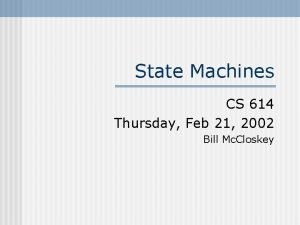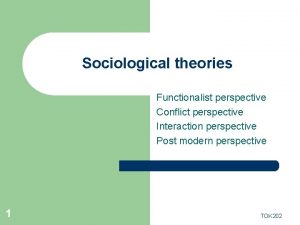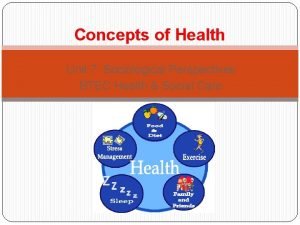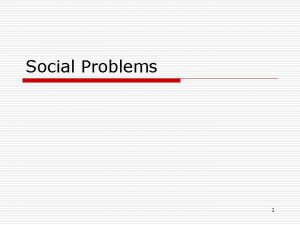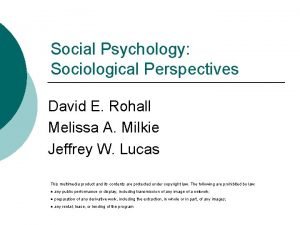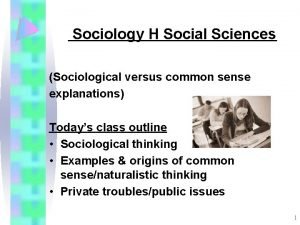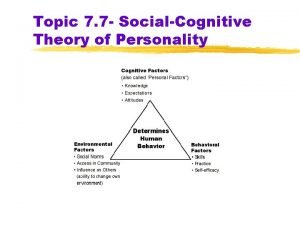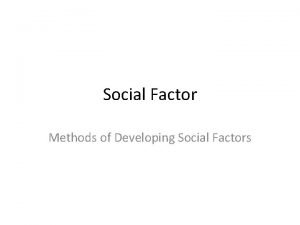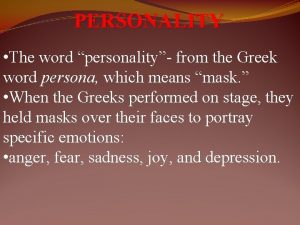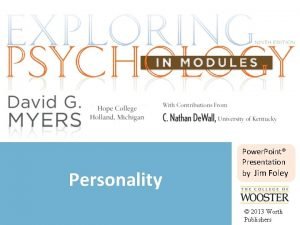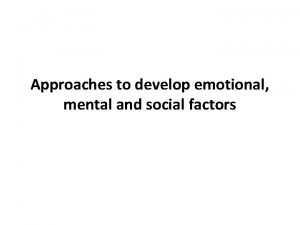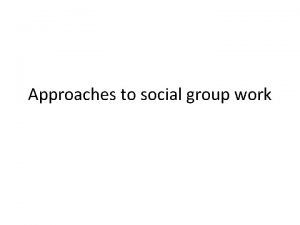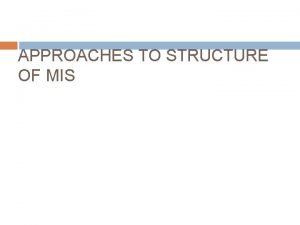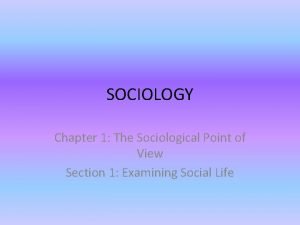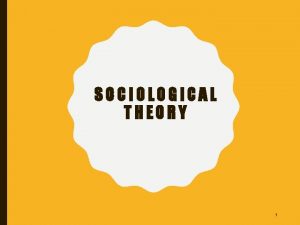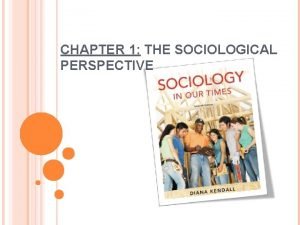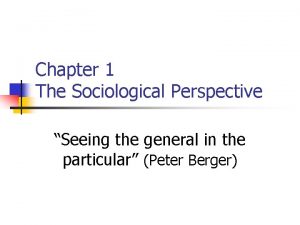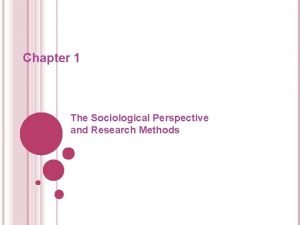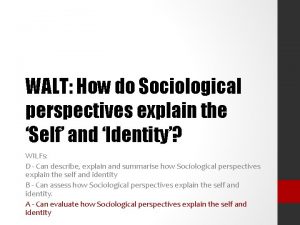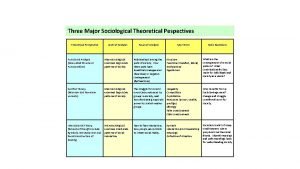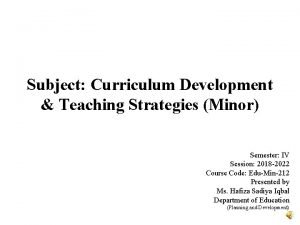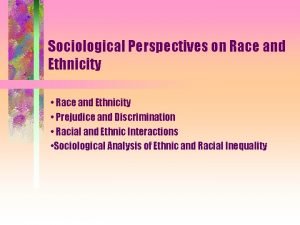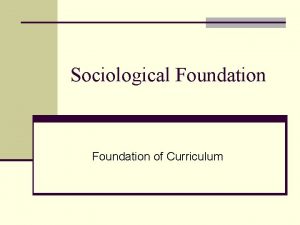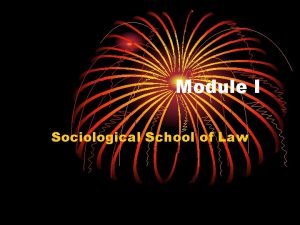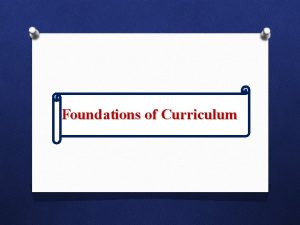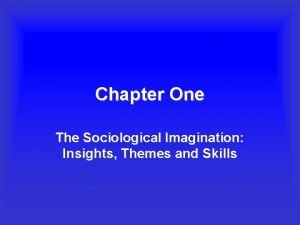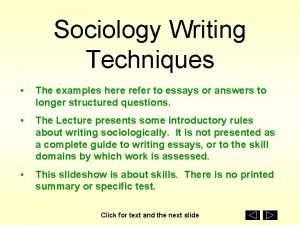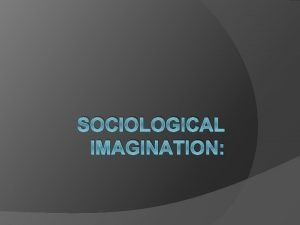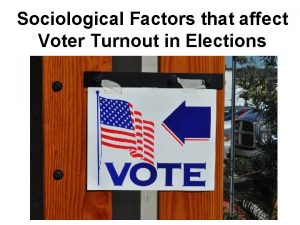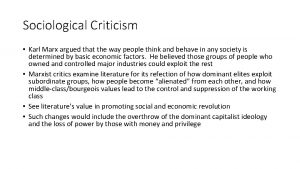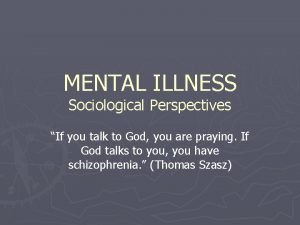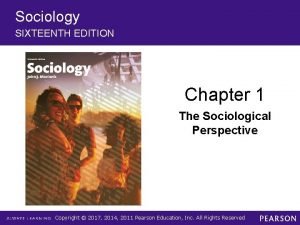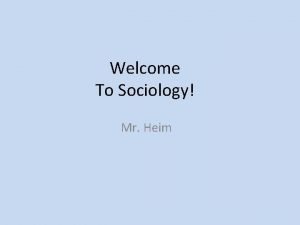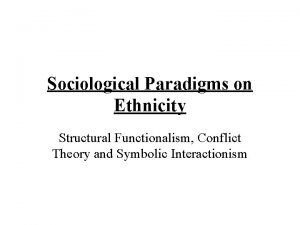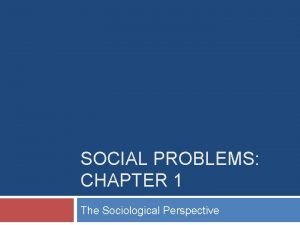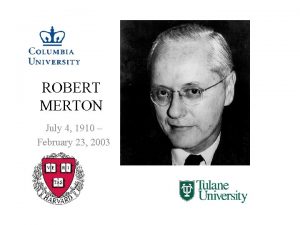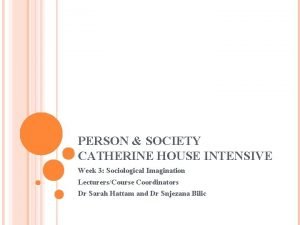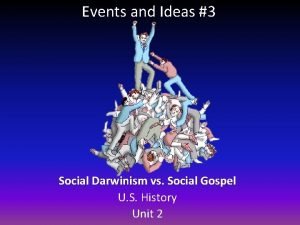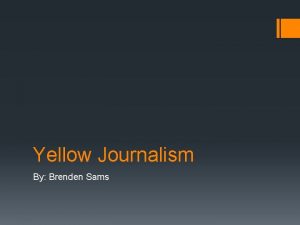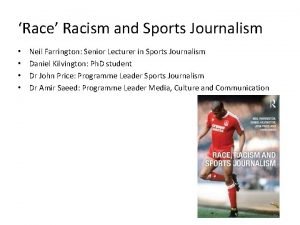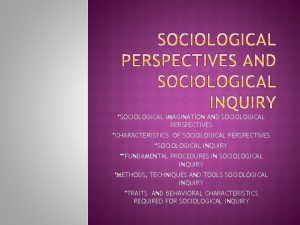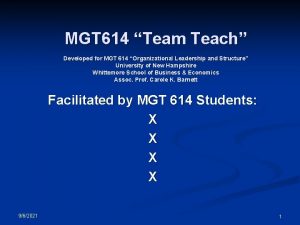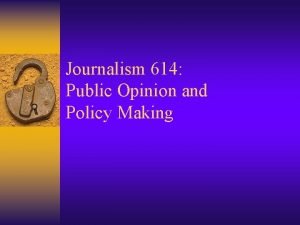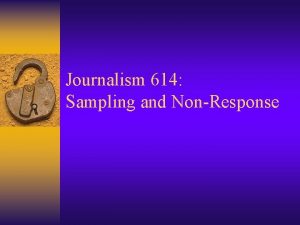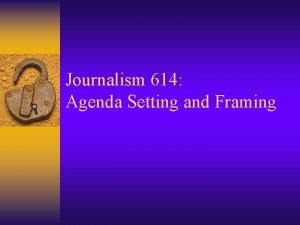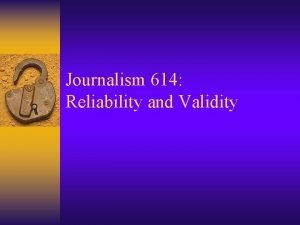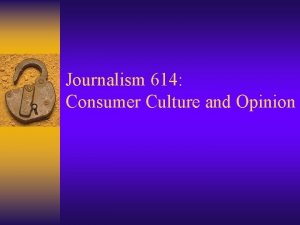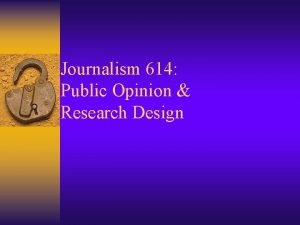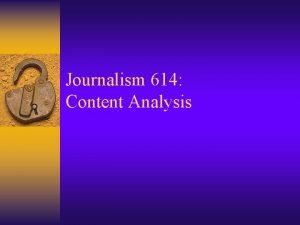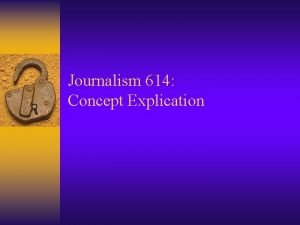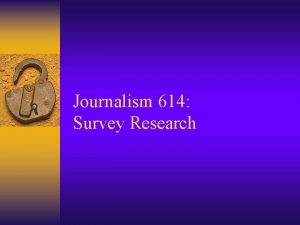Journalism 614 Sociological Approaches Social conflict and structure





































































- Slides: 69

Journalism 614: Sociological Approaches: Social conflict and structure

What are your social norms? ¨ What would spur a negative reaction? – from your peers? – from your family? ¨ What behaviors are taboo? – Social sanctions or isolation for adopting – Serious threat to social status

Sociological Approaches: ¨ Social Control ¨ Social Norms

1. Social Control ¨ Present in all social systems – Mechanisms for: • Establishing conformity, compliance, authority • Discouraging/punishing deviance ¨ Applies pressure on individuals through: – Incentives (rewards for conformity) – Sanctions (punishments for deviance)

Social Control Opinion ¨ Media as a system of social control – Provide acceptable latitude of response – Shape public opinion as the outcome ¨ Opinion shaped by message flows – E. g. , Current events • Fear and social control (high alert, global warming, economic collapse, impending war)

Opinion Social Control ¨ Public opinion as the causal force – Opinion as force that shapes mass behavior ¨ Mass opinion as a form of social control – Ex. Massive support for Bush post 9/11 limits citizens ability to speak out. – Outrage following Charleston church shooting and Charlottesville White Nationalist attack created context allowing for removal of Confederate symbols and monuments

2. Social Norms ¨ Norm: Expected pattern of behavior – Stereotypes of behavioral expectations – Shared norms: characteristic of all groups ¨ Norms (positive and negative aspects): – Maintain order (e. g. , stopping at red lights) – Enforce conformity (e. g. , keeping promises) – Reduce diversity (e. g. , clothing trends)

Enforcing Social Norms ¨ Social control: – Examples of social norm agents: • • • Parents - prescribed actions Peers - peer pressure Teachers - enforced expectations Religious institutions - moral guidelines Mass media - suggested exemplars Perceived opinion - acceptable lattitude

Norms are Situation-specific ¨ Jumping up and down shrieking – Yes: At a football game – No: In class ¨ Drinking beer – Yes: At a party – No: In class ¨ Walking around in your underwear – Yes: In a locker room – No: In class

Violation of Social Norms ¨ What about individuals that behave in ways that violate social norms? – Cognitive value • Attention-seeking • Ego-enhancement – Social value • Sub-group bonding • Conflict with larger group builds solidarity

Media, Social Control, and Social Norms ¨ Media convey social control/norm messages ¨ Coverage of public opinion as social control/norm messages: – 1. Public opinion poll reports – 2. Generalizations about public norms – 3. Ridicule “abnormal” behavior – 4. Suggest penalties for violations

Mass Society Theory ¨ Social transition from: – Homogeneous communities • Small, rural, tightly-knit, cohesive, personal • Gemeinschaft – To Heterogeneous communities • Large, urban, chaotic, transient, impersonal • Gesellschaft

Concerns about Mass Society ¨ Breakdown social ties, social order ¨ Anonymity, isolation, anomie, polarization ¨ Decline in public responsibility ¨ Potential for mass manipulation of publics – Isolation from others increases media power ¨ Concerns about media reinforcing norms that maintain economic/political institutions

Capitalism and Democracy ¨ Longstanding economic norms: – Self-reliance, competition, material acquisition, pursuit of profit, private property/ownership – Free markets as supreme economic guide – Legitimacy of business institutions ¨ Longstanding political norms: – Representative democracy, free speech, civil liberties, limited government, equality – Constitution as supreme political document – Legitimacy of political institutions

Conflict in Beliefs - Media ¨ Sometimes norms are in conflict – E. g. , Equality and capitalism • System based on inequity of outcomes • Equal opportunity, but not necessarily results • Problems admitting unequal opportunities ¨ Media can play an important role is setting the terms of the conflict, highlighting social divisions, and fostering consensus beliefs

Ex. Consensus Beliefs: American Dream ¨ Four tenets of the American Dream: – 1. American Dream should be open to all – 2. Belief in the probability of success – 3. Success and failure a function of effort – 4. Pursuit of material acquisition is a virtue

Battle Lines of Opinion Conflict ¨ Divisions within the consensus: – Social class – Political parties – Race/ethnicity – Gender – Geography

Social Class Divisions ¨ Most Americans think of themselves as middle class – Social class as a concept is relatively taboo ¨ Public support for income redistribution: – U relationship: Major difference: -Hi SES Liberals vs. Conservatives Lo Med Hi SES

Another Class Division ¨ Support for Civil Liberties – Hi SES: Greater support for individual liberties – Lo SES: Greater levels of authoritarianism • Research also shows that education contributes to more liberal orientations in high SES individuals

Political Party Divisions ¨ Democrats: – Liberal positions on social/economic issues • Support for reducing social and income disparities ¨ Republicans: – Conservative positions on social/economic issues • Support for free market and “law and order”

Racial/Ethnic Divisions ¨ America’s most salient divide ¨ Contrasting views on policies for fostering equality ¨ Strong alignment with party – Large differences in support for: • Affirmative action • Anti-discrimination policies • Support for the president…

Racial/Ethnic Divisions

Racial/Ethnic Divisions This is all from July 17 to 19, 2015

Gender Divisions ¨ The Gender Gap – In the 1980’s, political gap between men and women widens • • Women more likely to vote Democratic Women less supportive of wars Women less supportive of capital punishment Women more supportive of gun control ¨ Difference in motivations for participation: – Women more socially-motivated, men more economically-motivated

One thing brings all these groups together… AN EXTERNAL THREAT/ INTERNATIONAL CRISIS

Rallying around the Flag ¨ The propensity for the American public to put aside political differences and social cleavages to support the president, his policies, and the country during international crises

What is the rally effect? ¨ Robust phenomenon in public opinion ¨ Recurrent phenomenon in public opinion ¨ Occurs across political parties ¨ Occurs across a range of topics ¨ The public rallies behind leadership, roots for the nation, in times of crisis, attack, war

Traumatic Event: 9/11

The Start of War

Rallies Bolster Approval War begins

Comparable to Other Rally Events Terror Attacks Gulf War I Victory in WWII Pearl Harbor Cuban Missile Crisis

General Mood Also Rallies ¨ In general, are you satisfied or dissatisfied with the way things are going in the United States at this time?

Rallying Around the Economy Public expresses confidence in economy in spite of attacks Another rally effect, paralleling the other trends Right now, do you think that economic conditions in the country as a whole are getting better or getting worse?

Bush job approval by Party ID

Support for the war and Party ID

Satisfaction with U. S. by Party

But Rallies Fade….

Explanations of Rally Effects ¨ Psychologists – The Bandwagon Effect (Trotter) ¨ Sociology: – Conflict Functionalism theory (Coser)

The Bandwagon Effect ¨ Deep roots in Asch’s study of conformity – “following the lead of others” – Herd instinct ¨ Original concept from voting studies – Concern about bandwagon voting • “Going with the winner” – Initial leaders gain momentum – Primary elections as example

Obama as a Bandwagon Effect?

Trump as a Bandwagon Effect?

Conflict Functionalism ¨ Elaborate theory of: – Conflict dynamics – Functions ¨ Core principle: – Conflict with an external group increases internal solidarity – Principle applies at many levels: • From roommates to nations

Conditions for Rally Effects ¨ International conflict ¨ Vilified enemy ¨ Decisive action taken by the President ¨ Short Duration ¨ Successful Resolution ¨ Substantial media attention ¨ High public interest ¨ Official control of info flow

War, Media, & Rallies ¨ War changes importance of media roles: – Providing information (decreases) – Explaining significance (decreases) – Building solidarity (increases) – Reducing tension (increases)

Identifying the Enemy ¨ Conflict Functionalism relies on enemy – Vilified enemy - External source of conflict – Power of rally enhanced by demonized enemy ¨ Governments also recognize this power: – Leads to use of propaganda

Propaganda Techniques ¨ Classic techniques of demonization – Lee & Lee (1939) and (1952) • identify 9 common techniques • First book analyzed Father Coughlin speeches • Second is systematic study of propaganda ¨ Function: – Induce motivation to fight – Frame issue and parties to conflict – Stimulate and manage opinion formation – Enhance rally effects



Animalistic Imagery

Animalistic Imagery



















The tools have changed but the underlying themes remain as a means to target enemies
 Sociological imagination vs sociological perspective
Sociological imagination vs sociological perspective Cs 614
Cs 614 914-614-3221
914-614-3221 Traditional journalism vs literary journalism
Traditional journalism vs literary journalism Literary journalism vs traditional journalism
Literary journalism vs traditional journalism Functionalist vs conflict theory
Functionalist vs conflict theory Unit 10 sociological perspectives
Unit 10 sociological perspectives Define social issue
Define social issue Social psychology sociological perspectives
Social psychology sociological perspectives Internal vs external conflict
Internal vs external conflict What is conflict and conflict resolution?
What is conflict and conflict resolution? One subcategory of external conflict is
One subcategory of external conflict is Examples of common sense and sociological explanations
Examples of common sense and sociological explanations Social cognitive approaches to personality
Social cognitive approaches to personality Approaches to develop social factors
Approaches to develop social factors Social cognitive approaches to personality
Social cognitive approaches to personality Greek word for personality
Greek word for personality Social cognitive approaches to personality
Social cognitive approaches to personality Approaches to develop social factors
Approaches to develop social factors Group work meaning
Group work meaning Elements of mis
Elements of mis Social thinking adalah
Social thinking adalah Social thinking social influence social relations
Social thinking social influence social relations Sociological theory of crime
Sociological theory of crime Sociological theory in corporate governance
Sociological theory in corporate governance What sociological perspective stresses that age
What sociological perspective stresses that age By adopting a sociological imagination
By adopting a sociological imagination Sociological theories
Sociological theories Micro sociological perspective
Micro sociological perspective Sociological literary criticism
Sociological literary criticism Sociological globalization example
Sociological globalization example Macro sociology examples
Macro sociology examples Chapter 1 the sociological perspective
Chapter 1 the sociological perspective Peter berger seeing the general in the particular
Peter berger seeing the general in the particular Chapter 1: the sociological perspective answers
Chapter 1: the sociological perspective answers The looking glass sociology
The looking glass sociology Three major sociological perspectives
Three major sociological perspectives Pragmatism and curriculum
Pragmatism and curriculum Sociological perspective on race in philippines
Sociological perspective on race in philippines The sociological perspective is a point of view that
The sociological perspective is a point of view that Social foundation of curriculum
Social foundation of curriculum Duguit theory
Duguit theory New historicism literary theory
New historicism literary theory Sociological perspective
Sociological perspective Sociological foundation of curriculum
Sociological foundation of curriculum The sociological imagination chapter 1 summary
The sociological imagination chapter 1 summary Sociological imagination abortion
Sociological imagination abortion Technique in writing sociological
Technique in writing sociological Sociological imagination examples race
Sociological imagination examples race Structured interview
Structured interview Youtube sociological imagination
Youtube sociological imagination Sociological factors that affect voting behavior
Sociological factors that affect voting behavior What is sociological criticism
What is sociological criticism Research that translates the social world
Research that translates the social world Sociological perspective on mental health
Sociological perspective on mental health Sociology 16th edition
Sociology 16th edition Sociological.imagination
Sociological.imagination Explain structural functionalism
Explain structural functionalism Social issue examples
Social issue examples Conformity; innovation; ritualism; retreatism; rebellion *
Conformity; innovation; ritualism; retreatism; rebellion * Social logical imagination
Social logical imagination Aliran sociological jurisprudence
Aliran sociological jurisprudence Dan lortie
Dan lortie Social darwinism vs social gospel answer key
Social darwinism vs social gospel answer key Venn diagram literature and journalism
Venn diagram literature and journalism How did yellow journalism and jingoism influence
How did yellow journalism and jingoism influence Journalism based on sensationalism and crude exaggeration
Journalism based on sensationalism and crude exaggeration Yellow journalism
Yellow journalism Race racism and sports journalism
Race racism and sports journalism Conflict theory of criminology
Conflict theory of criminology

